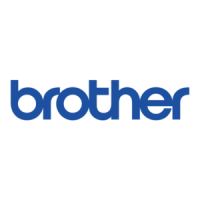
Do you have a question about the Brother MFC-7380 and is the answer not in the manual?
| Functions | Print, Copy, Scan, Fax |
|---|---|
| Print Technology | Laser |
| Print Resolution | 2400 x 600 dpi |
| Duplex Printing | Manual |
| Copy Resolution | 600 x 600 dpi |
| Scanner Type | Flatbed |
| Fax Modem Speed | 33.6 Kbps |
| Paper Capacity | 250 sheets |
| Connectivity | USB 2.0 |
| Scanner Resolution | Up to 19200 x 19200 dpi (interpolated) |
| Fax Transmission Speed | Approx. 3 seconds per page |
| Automatic Document Feeder (ADF) | Yes, 35 sheets |
| Supported Media Sizes | Letter, Legal, A4, A5, B5 |
| Toner Yield (Standard) | 1200 pages |
| Toner Yield (High-Yield) | 2600 pages |
Declares product compliance with essential EU directives.
Declares conformity with R&TTE Directive for radio/telecom interfaces.
Specifies Class 1 laser product compliance per IEC60825-1:2007.
States product supports Wireless LAN connectivity.
Safety instruction to disconnect power in emergencies.
Wiring precautions and color coding for UK power cords.
Caution against connecting to over-voltage LAN.
Statement of compliance with EN55022 (CISPR Publication 22)/Class B.
Disposal guidelines for product/battery according to WEEE/Battery Directives.
Confirms product meets ENERGY STAR specifications for energy efficiency.
FCC compliance statement for Class B digital device.
FCC/IC radiation exposure compliance and installation guidelines.
Mexican regulations for wireless operation, two conditions listed.
Industry Canada RSS compliance statement, two conditions listed.
Technical specifications and Ringer Equivalence Number notice for Canada.
Laser safety information for 110-120V models, Class 1 laser product.
FDA regulations for laser products manufactured in the US.
Statement regarding product usage limitations to USA/Canada regions.
Explains the conventions used for warnings, cautions, notes, and memos in the manual.
General safety instructions for operating and maintaining the machine.
Cautions regarding servicing the laser unit and avoiding direct laser beam exposure.
Warning about reflective objects and laser beam damage to eyes during servicing.
FCC notices and telephone connection guidelines for MFC models sold in the US.
Information on illegal document reproductions and prohibited copying.
Comparative table of functions for various Brother printer models.
Details on wired and wireless network node types for different models.
Machine life, part life, MTBF, MTTR, and periodical maintenance parts.
Information on toner cartridge and drum unit specifications, including page yield and shelf life.
Specifications for paper input, media weight, and media size for the ADF.
Fax specifications including modem speed, transmission speed, and ITU-T group.
Copy speed, first copy out time, resolution, and auto duplex scanning copy features.
Scanner specifications including resolution, scanning speed, and interpolated resolution.
Explains the purpose of the chapter: typical problems and recovery procedures.
Pre-troubleshooting checks for operating environment, power supply, paper, and consumables.
Provides diagrams and descriptions of the printer and scanner parts.
Illustrates the main internal components of the machine.
Details machine error codes and their potential causes and remedies.
Lists error codes, descriptions, and corresponding page references for troubleshooting.
Lists error messages displayed on LCD for 2-line and touch panel models with descriptions.
Lists communication error codes, their causes, and refer-to pages.
Provides step-by-step solutions for common machine errors and problems.
Details specific error codes, their causes, and remedies, often with step-by-step instructions.
Addresses issues like no paper fed, multiple sheets fed, paper jams, and curling.
Covers common image defects like light print, dark print, streaks, and fogging, with causes and remedies.
Solutions for software-related issues like inability to receive data or update firmware.
Steps to resolve network connectivity issues like inability to print or connect to access points.
Solutions for issues related to the control panel, LCD, or LED displays not working.
Addresses issues with new toner detection, cartridge recognition, and error messages not clearing.
Troubleshooting steps for fuser unit failures.
Steps to diagnose and resolve laser unit failures.
Solutions for issues related to Main PCB, memory, or print limit errors.
Covers problems with document feeding in the ADF, such as jams or incorrect size detection.
Details troubleshooting steps for various image quality defects like light print, dark print, and streaks.
Solutions for fax transmission and reception issues like cannot send/receive or communication errors.
Addresses general problems like inability to print, update firmware, or turn on the machine.
Important warnings and precautions for performing disassembly and reassembly.
Illustrates the packing procedure and components for shipping or storage.
Lists and illustrates various screw types used in the machine.
Provides torque specifications for screws used in different assemblies.
Details lubricating points and types of oil/grease used for machine parts.
Shows layout and development views of the gear system with part names.
Illustrates the routing paths for various wiring harnesses within the machine.
A visual guide showing the sequence of disassembly and reassembly steps.
Step-by-step instructions for disassembling various parts and units of the machine.
Instructions for preparing the machine before disassembly, including transferring FAX data.
Procedures for setting by spec, installing firmware, and initializing EEPROM after PCB replacement.
Steps to reset the irregular power supply detection counter after replacing the LVPS PCB.
Procedure for entering the adjusted value of the laser unit after replacement.
Instructions for installing firmware, adjusting touch panel, and checking LCD operation.
Steps for acquiring white level data and performing scanning/printing checks after CIS/scanner replacement.
Procedures for acquiring white level data and checking ADF/CIS performance after replacement.
Introduction to using function codes for machine maintenance and adjustments.
Explains how service personnel can access the machine's maintenance mode.
A table listing all available maintenance mode functions with their codes and refer-to pages.
Detailed descriptions and operating procedures for various maintenance mode functions.
Procedure to initialize EEPROM parameters for operation, user switches, and worker switches.
Prints contrast level data for document scanning compensation.
Tests the performance of the automatic document feeder by counting scanned pages.
Prints monochrome test patterns to check image quality and detect missing images.
Allows setting and printing worker switch configurations for machine functions.
Verifies the normal operation of the LCD display on the control panel.
Checks if all keys on the control panel are functioning correctly.
Displays operation data, version, and checksum information for software parts.
Enables or disables the Demo printing function for sales promotion.
Checks the status and operation of various sensors within the machine.
Checks the connection status of the wired LAN.
Allows changing various print function settings for PC printing.
Manages USB serial number return values and adjusts duplex print alignment.
Customizes EEPROM settings for language, function settings, and firmware switches.
Transfers received fax data, log information, communication reports, or machine logs.
Adjusts the scanning start and end positions for ADF and FB scanning.
Acquires CIS unit white level data and stores scan area in EEPROM.
Calibrates the touch panel for accurate input.
Conducts paper feed and eject tests while printing patterns.
Prints a frame pattern on one side of paper to check print quality.
Prints frame patterns on both sides of paper to check print quality.
Prints test patterns to check developer roller or exposure drum condition.
Customizes machine settings like language, function settings, and worker switches.
Prints consumables status, replacement counts, and counter information.
Checks fan operation at different speeds (100%, 50%, OFF).
Displays machine log information including error logs, serial numbers, and page counts.
Displays the latest machine error code on the LCD.
Sends error lists to service personnel for fax communication problem analysis.
Resets the counter after replacing the low-voltage power supply PCB.
Exits maintenance mode, restarts the machine, and returns it to the ready state.
Lists additional service functions available for the machine.
Prints the communication error list for troubleshooting.
Provides a schematic diagram illustrating the electrical connections within the machine.
States that there are no parts that require periodic replacement.
Explains how to read and locate the machine's serial number label.
Procedure to reset machine user settings to default configurations.
Step-by-step guide for installing the maintenance printer driver on Windows XP.
Installation guide for the maintenance printer driver on Windows Vista/7/8/8.1.

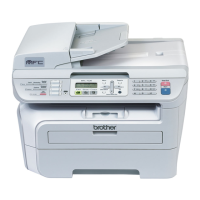
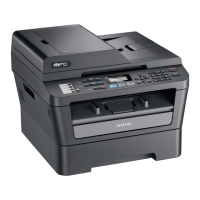
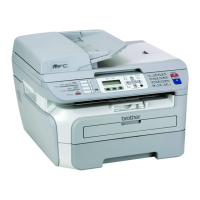

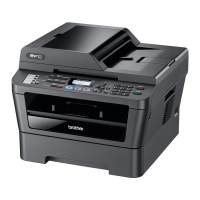


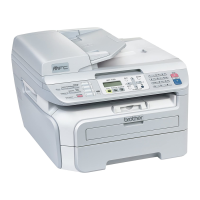
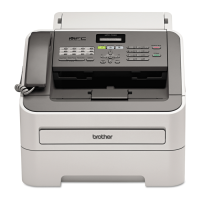
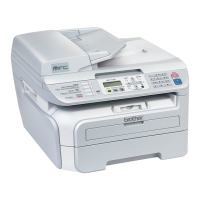
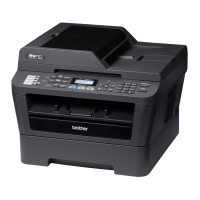
